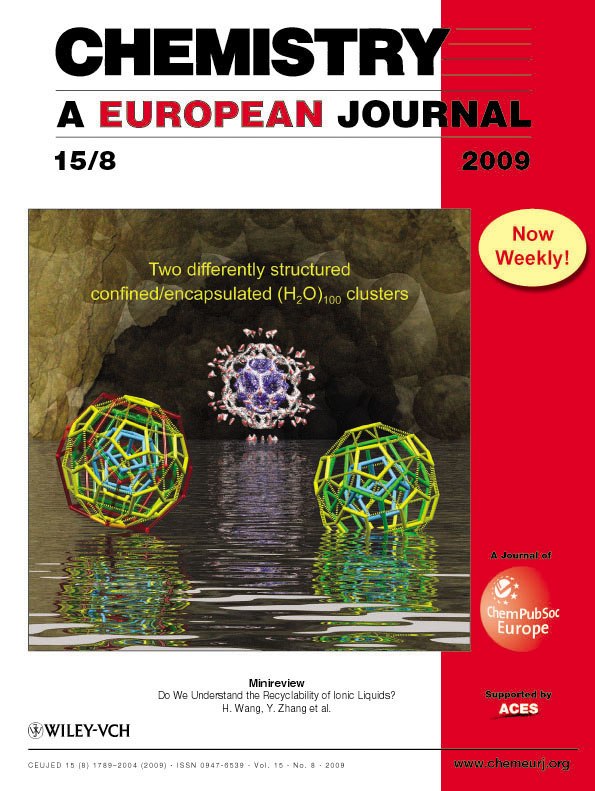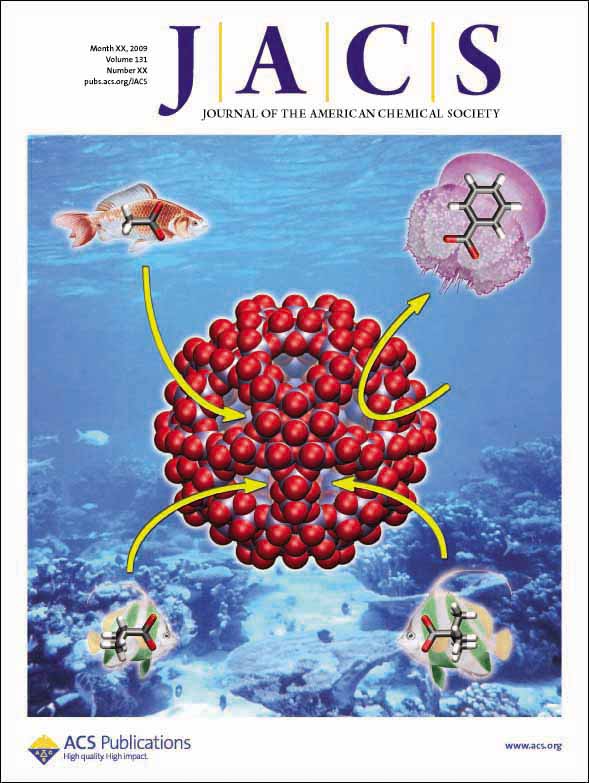
Structurally well-defined spherical porous metal-oxide based nanocapsules of the type {Pentagon}12{Linker}301-3 allow unprecedented chemistry including catalytic(!) reactions4 which can be performed in the cavities, in the pores and at the surfaces;3 interestingly, the size of the capsules and their 20 pores can be varied.3 As the pores have crown ether function they can - based on sphere surface supramolecular chemistry - be stepwise opened and closed with appropriate corks/guests3 (Fig. 1 top right) while according to their flexibilities uptake of compounds larger than the pores is possible (see below). The internal cavities' shells can get differently functionalized which influences the structures of encapsulates, e.g. in case of the (inverse micelle type) butyrate-24 aggregate5 (Fig. 1 bottom right) and of higher and lower density water molecule assemblies (see below).

The capsules interact specifically with their environment, e.g. with cations (Fig. 1 top left) - allowing after their uptake their nanoscaled separations corresponding to a nano-ionchromatograph principle and to model transmembrane cation transport3 - but also with themselves in aqueous solution leading to giant spherical supramolecular aggregates (Fig. 1 bottom left - here shown for molybdenum-oxide wheels6). A comparable scenario can, remarkably, lead to a new type of self-recognition process: the two spherical {Pentagon}12M30 (M = FeIII, CrIII) type capsules - both having the same surface like a nano drop of water - assemble in solution to two separate spherical structures without interference.7
Present investigations refer especially to the study of hydrophobic effects which play a major role in a variety of important phenomena, for example in protein folding and formation of lipid bilayers as well as the insertion of proteins into biological membranes. Investigations were performed within the porous capsules of the type {Pentagon}12{Linker}30 ≡ {(M) M5}12{MoV2 (Ligand)}30 (M = Mo, W), which can be constructed with varying hydrophobic interiors, i.e. "ligands" and therefore, with different amounts and structures of encapsulated water (see below) or hydrophobic materials. In a special case, it could be shown that capsules containing 30 hydrophobic propionate ligands allow the removal of (toxic) hydrophobic species like n-hexanol molecules from water solutions corresponding to their uptake and appropriate internal interactions, i.e. hydrophobic clustering. The latter could be studied by NMR spectroscopy.8a (This effect leads - in the presence of butyrate ligands - to the formation of an encapsulated unique butyrate-24 micelle-like aggregate containing a hydrophobic cavity5 already mentioned above; Fig. 1 bottom right.) The mentioned processes were considered as a paradigmatic shift with respect to molecular recognition and clustering of hydrophobic materials in water. Remarkably, it was also possible to study - with EXSY-NMR spectroscopy - uptake-release guest exchange processes simultaneously with the exchange between guests like acetate positioned on different sites inside a capsule - an interesting artificial cell scenario.8b
One important result/aspect refers to considering "water" in hydrophobic cavities (like in protein pockets). In a remarkable scenario within a nanocapsule an unprecedented segregation between the mostly hydrophobic internal capsule wall - spanned by the acetate/water ligand arrangement - and an encapsulated "water molecule collection"9a forming an unprecedented spherical shell with strongly interacting molecules can be observed (Fig. 2). We can refer to a molecular Lotus effect or to "Water's response to the fear of water".9b Importantly, one can influence the type of "water assembly" by changing the ratio of acetate and water ligands, that is, the hydrophobicity.

In a special case - only considered here for completeness - a highly symmetrical (H2O)100 cluster is formed3,10 (Fig. 3 left) in a special hydrophilic capsule while it is remarkably even template driven3,10 (Fig. 3 right). The Figure shows correspondingly three O5 (water) pentagons extracted from the water cluster of Figure 3 left, while the yellow pentagon is formed by the template effect of the O5 (water ligand) pentagon (red) of the capsule skeleton.3,10 By changing the internal hydrophilic ligands regarding their sizes also "higher and lower density water" can be generated/encapsulated10a (Fig. 4).



Our interest in the future will focus especially on the high reactivity (including related catalysis) of the 60 unsaturated MoV Lewis acid centers within the capsule interior3,11 (which can easily be generated), furthermore on molecular porosity12 (Fig. 5), and chemical adaptability13 (Fig. 6).


The mentioned metal-oxide nano-objects were used by several groups because of their easy preparation14 in context with experiments of importance for materials science (for examples see ref. 3).